The Thermal Data
Moving on from the restriction test bench the HWLabs SR2 Multi-Port was loaded into the thermal test chamber for a series of tests – consisting of 3 flow rates, each having 3 different fan rpm rates tested. I felt the thermal test data was most important and which you as the reader would be most interested in.
Below is the final data results gathered from at least 2 data logging runs at each flow rate and fan rpm combination. The most stable 15 minute period from each logging run was used and then averaged with the other runs to obtain the data for the table below. A total of 16 temperature sensors were used in the thermal test chamber (8 air in, 2 air out, 3 water in, 3 water out) each take a reading every second and logged via a CrystalFontz unit. The data in the table below is the averaged results of the logging runs which has then been used to create all the plots and tables there-after.
The performance metric of critical importance is the delta between the warm coolant temperature in and the cold ambient air temperature in to the radiator. Given that the system is well insulated and in equilibrium and we know the heat input to the system then we can also calculate a very important number – that is the amount of power required to raise the coolant temperature 1C (or 10C which is more useful reference point).
Let’s take a look at the Delta T results from the tests, in bar chart form first:
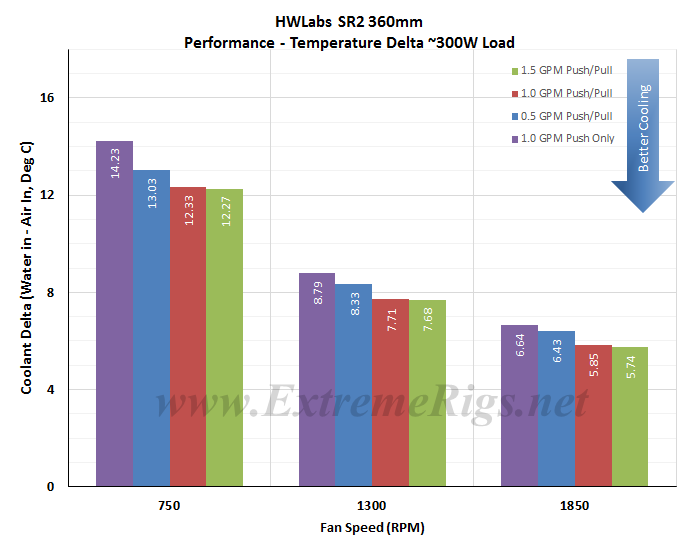 I was not too concerned about the actual delta numbers, more so the trend pattern. Most noticeable here is the lack of variation between the 1.0 and 1.5 gpm test results. Is this a clue to the SR2’s sweet spot for performance in relation to flow rate? This results seems unusual – but we have to remember the total system power varies with flow as the pump dumps heat to the loop so let’s not read too much into this just yet.
I was not too concerned about the actual delta numbers, more so the trend pattern. Most noticeable here is the lack of variation between the 1.0 and 1.5 gpm test results. Is this a clue to the SR2’s sweet spot for performance in relation to flow rate? This results seems unusual – but we have to remember the total system power varies with flow as the pump dumps heat to the loop so let’s not read too much into this just yet.
Delta T results (as above) are not always helpful when thinking about how many radiators you would need to cool your system. Instead it’s more useful to know the delta/W, or more usefully, the inverse metric of W/delta C. The metric plotted below tells us how many watts are dissipated by the radiator when the coolant rises 10C above ambient temperatures (W/10 Delta T):
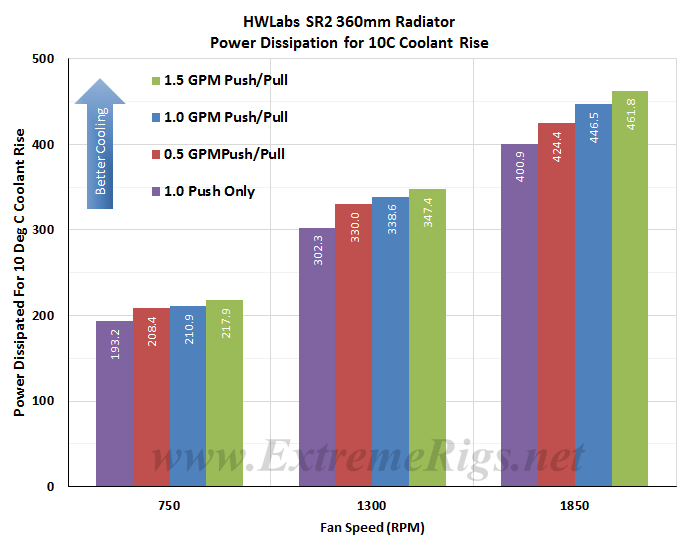 As expected increasing airflow through the radiator is the primary determinant in changing the radiators performance.
As expected increasing airflow through the radiator is the primary determinant in changing the radiators performance.
Notice that we are not seeing much performance gain as the flow rate is increased. This could prove interesting in the comparisons later on. Are the SR2’s low flow results very good, or are the high flow gains lower than we would normally see?
This data can now be plotted as a pretty curve so that an end-user can interpolate their own fan speed. Note again that the extrapolation of the curve is much more sensitive to error than in between the tested range. Let’s exclude the push data for now and come back to it:
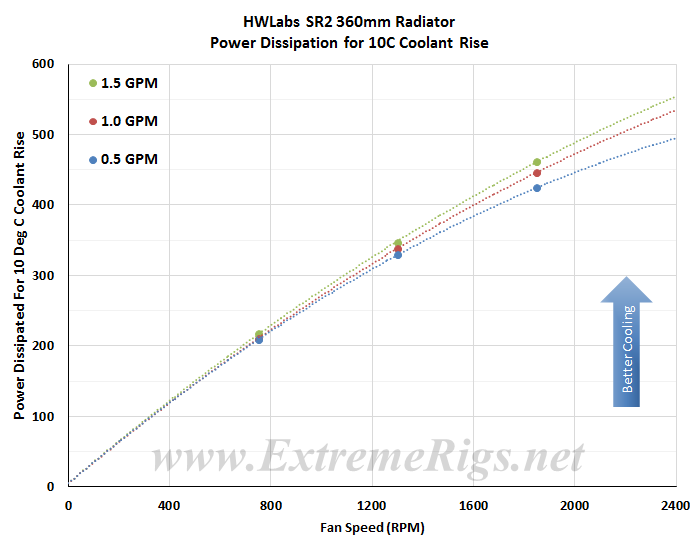 Evidence again that increasing flow rate is yielding very little benefit in performance as the fan speed is increased. Note also the trajectory of the curve – this is a radiator that has “room to grow” with higher fan speeds and hasn’t ran out of breath.
Evidence again that increasing flow rate is yielding very little benefit in performance as the fan speed is increased. Note also the trajectory of the curve – this is a radiator that has “room to grow” with higher fan speeds and hasn’t ran out of breath.
If we now come back to the push data it’s good to compare only the push to push/pull data in an “apples to apples” fashion by only looking at the 1GPM data:
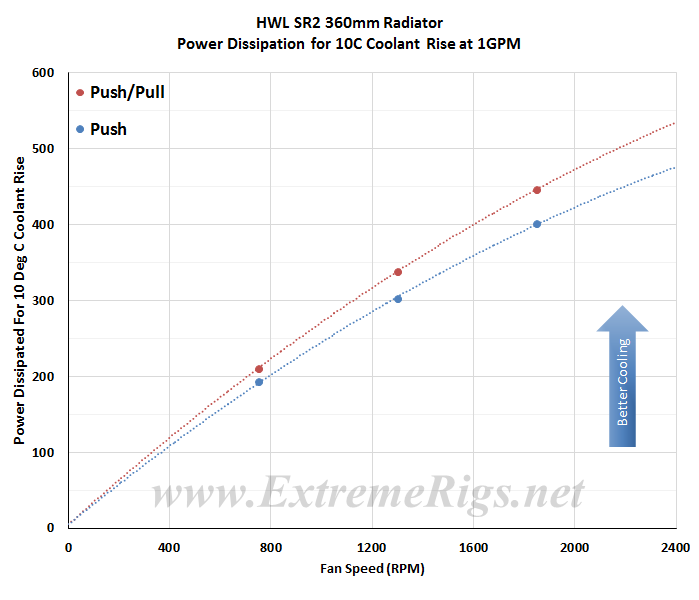 Push Only gives around 90% (averaged) of the performance of the Push/Pull 1.0 gpm test results on this radiator.
Push Only gives around 90% (averaged) of the performance of the Push/Pull 1.0 gpm test results on this radiator.
In this next plot all three Push/Pull results at each flow rate were averaged to produce one curve and we compared the results against one of the best and worst performers from the first test group. Averaging reduces test error of course so this helps further to be sure of our data and is more useful therefore for comparing to other radiators.
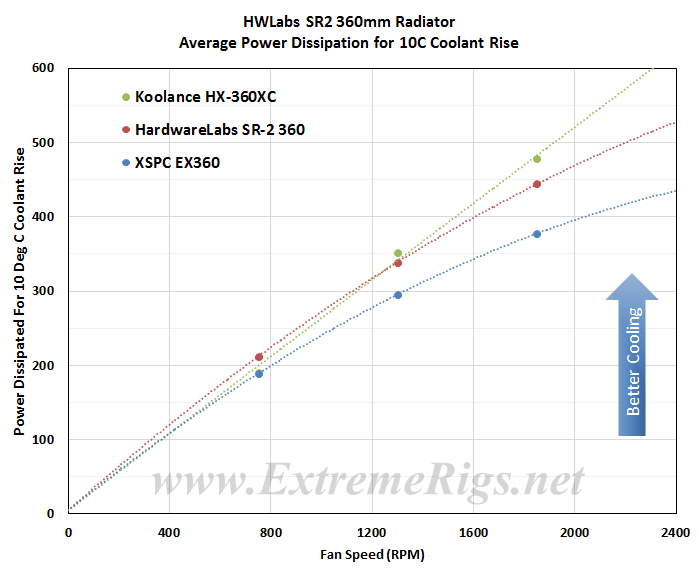 As you can see the SR2 clearly is beating both at low fan speeds and only begins to taper off from the Koolance once medium fan speeds are reached.
As you can see the SR2 clearly is beating both at low fan speeds and only begins to taper off from the Koolance once medium fan speeds are reached.
Now let’s analyze that data some more…







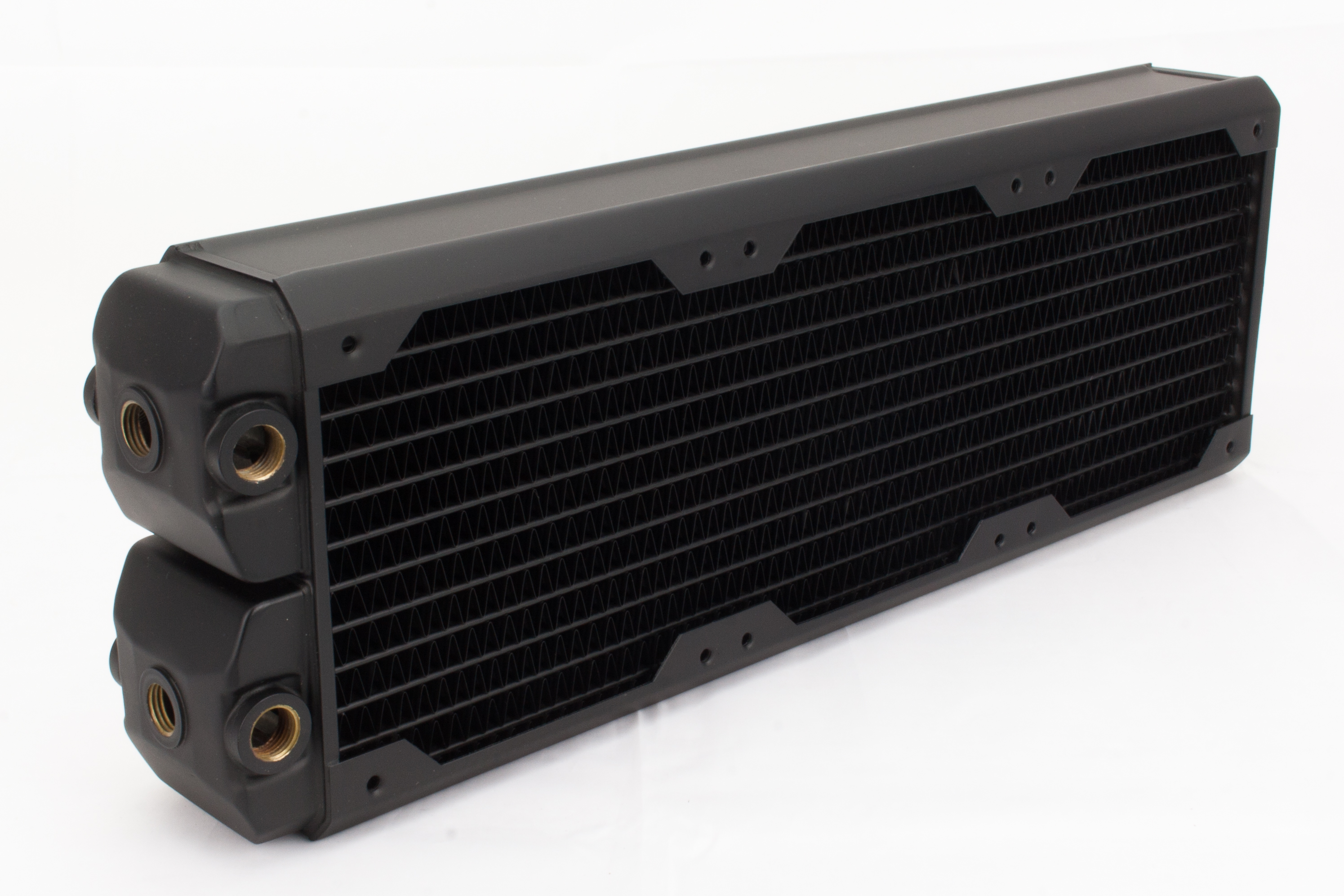
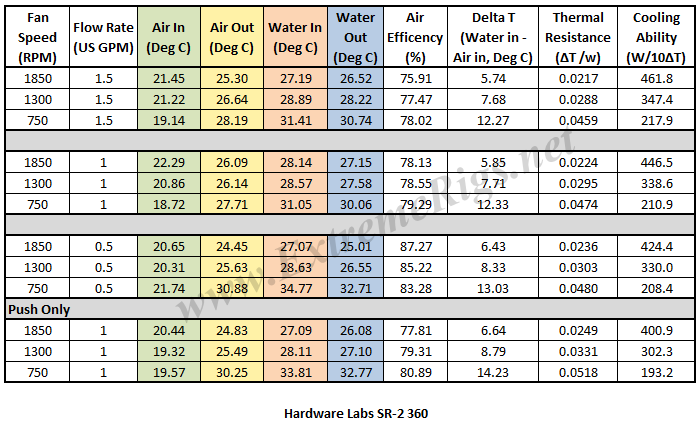



What are these “Opti-flow” versions of radiators? I can find no such variant on Hardware Labs website, only the “XFlow” variety.
Hey Thomas – the “optiflow” refers to radiators where the direction of coolant or airflow matters. “Optiflow” means that the “best” orientation is being tested. It only applies therefore to certain radiators with certain internal structures such as the Nemesis GTX or Black Ice GTX. The SR2 does not have any such directionality 🙂
Also on more thing to add – optiflow significantly helps lower flow rates when air flow is higher. If you run low airflow or high coolant flow then a directional radiator can be more of a pain than a gain.
Ah, thank you!
So between the SR2 and Nemesis GTX which performs better seems to be entirely down to the particulars of your setup then (as the Nemesis seems to straddle the SR2 results with and without opti-flow), will have to reread the Nemesis review as I don’t remember seeing anything about this issue.
Great work, love these reviews and the roundup comparisons (any chance there will be a 140mm variant of it some time too?).
Awesome review thanks for all the hard work!!
Nice review man,
I gotta get me on of this multiport when it comes out 🙂
Awesome review, I really want one too.
Great review as always
[…] Nemesis GTS 360 Radiator Hardware Labs Nemesis GTX 360 Radiator Hardware Labs SR-1 360 Radiator Hardware Labs SR2 360 Radiator Koolance HX-360XC 360 Radiator Magicool G2 Slim 360 Radiator Mayhem’s Havoc 360 Radiator […]
[…] a close look at the SR2 240 MP from Hardware Labs. We took a look a pre-production sample of the 360mm version for the round-up, so if the 360mm size is more your flavor be sure to check out it’s full review […]
If you don’t mind? What advice do you have to offer concerning the first model of SR2 radiator performance as compared to the SR2-MP? Is this simply a feature added change with the same performance? Or an attempt at both adding features while improving performance?
The SR2 and SR2 MP have the same core – there *should* be no performance difference and it should only be additional features 🙂
[…] up is the SR2 420 MP from Hardware Labs. We’ve already reviewed the 240 mm and 360mm versions of the SR2 MultiPort so be sure to check them out after you’ve finished reading this […]
[…] for sub-800 rpm ultra-stealth fans” which proved to be be an accurate statement when we tested the 360mm version earlier in the year. Will the 140mm perform as well ? We’ll find out how it performs and […]
Comments are closed.